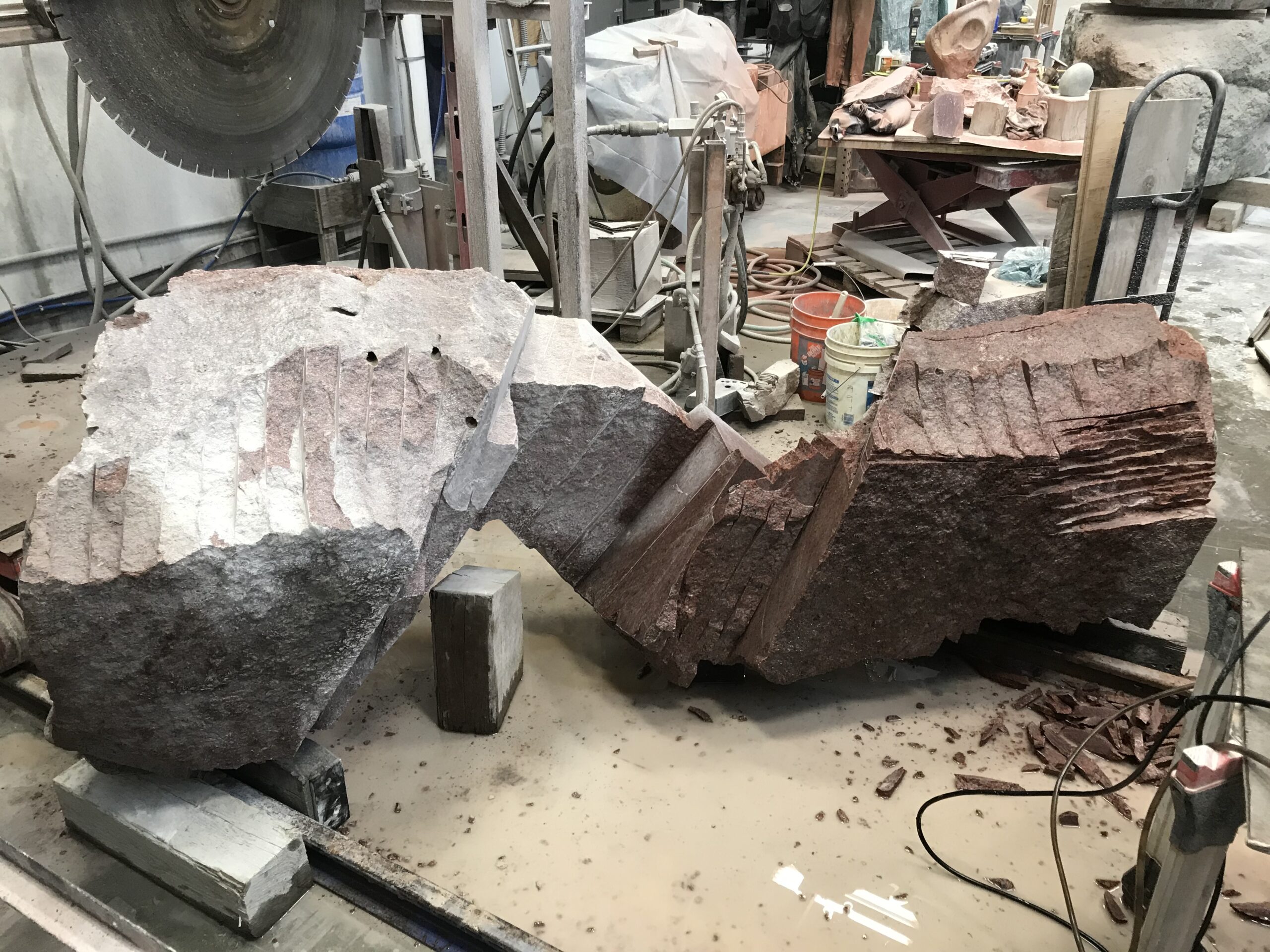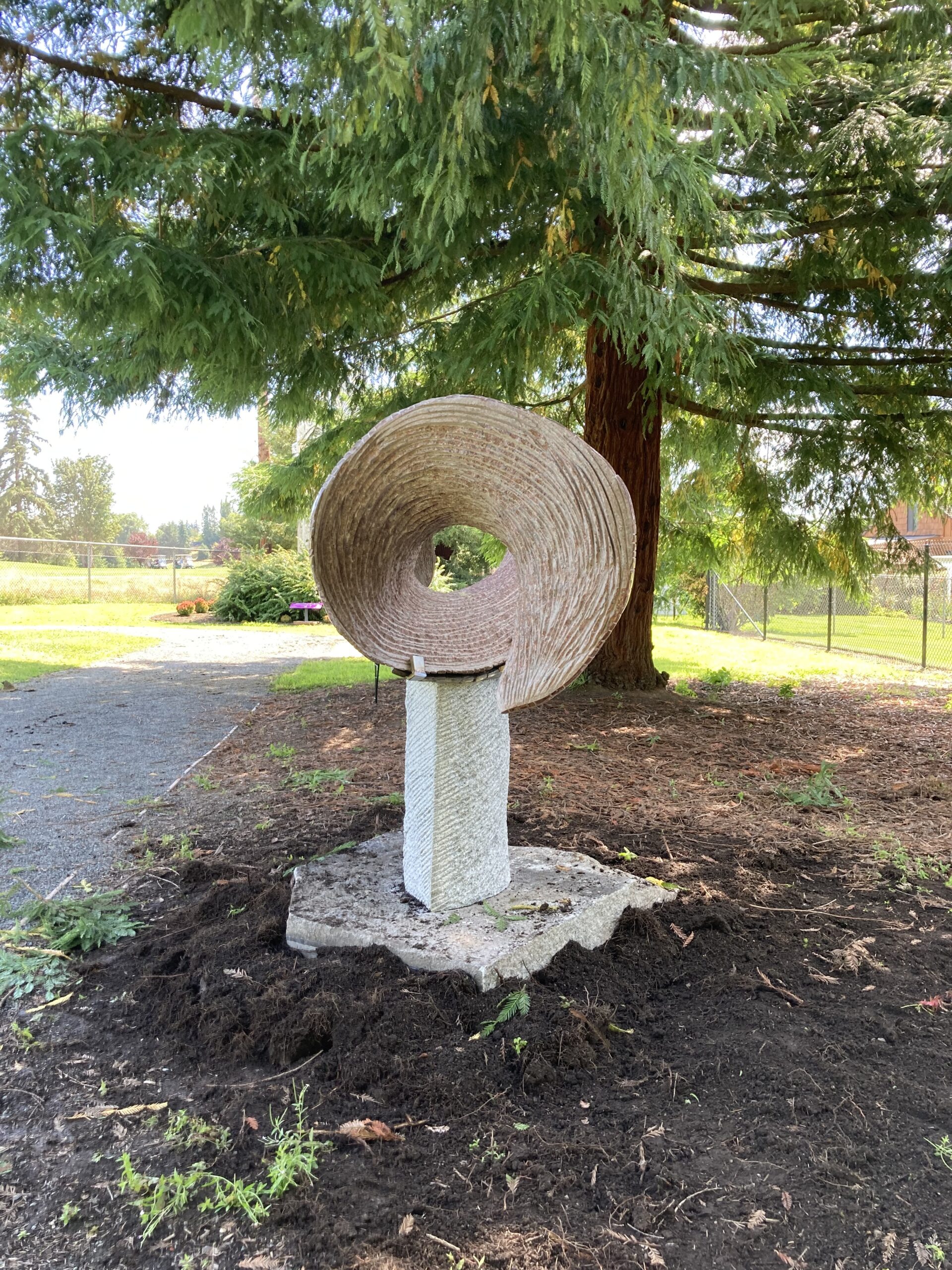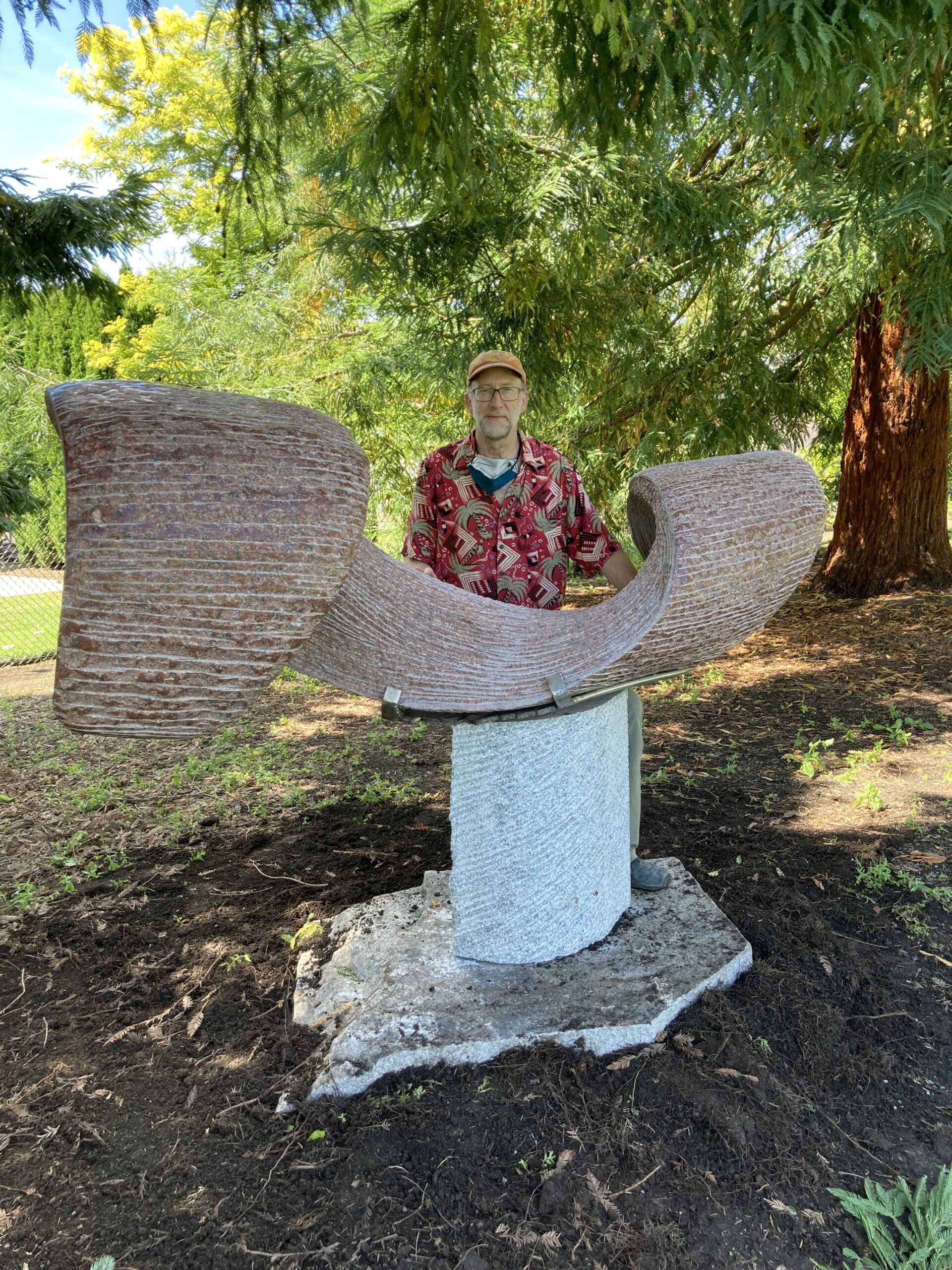Home » NWSSA Events » How I Spent the First Six Months of the Pandemic
We have all experienced the pandemic isolation in our own ways. As an introvert, I was thrilled by the requirement to stay home. And I was blessed to have a studio there. I decided it was time to return to the red granite piece I had started about 5 years earlier at Pilgrim Firs.  The stone was an 8-foot-long narrow rectangle of Wisconsin Red granite. I had initially been attracted to the stone due to the color, shape and the fact the rectangle was twisted. The sculptor John Hoge had collected this stone, along with many others and he needed to get these stones off his neighbor’s property. While looking at the collection John had said to me “Do you like this one?” and I said “I don’t know what I would do with it. Let me think about it” and turned my attention to various stones at the far side of the yard. When I came back, he had already loaded the stone on my truck. In sales they call that the “presumptive close”. I laughed and said “sure”. After looking at the stone for a while in my studio I decided a spiral would work well. I had done a small spiral out of a core a few years earlier and that had been very successful. I was also wondering about the 3D shape of spiral galaxies. The telescopic images we see look like a flat spiral drawn with fairy dust on a black background. If we could view these spiral galaxies from the side, would they really be flat, or could they be a more stretched out spiral? I’ll never experience this view, but I could create it in stone.
The stone was an 8-foot-long narrow rectangle of Wisconsin Red granite. I had initially been attracted to the stone due to the color, shape and the fact the rectangle was twisted. The sculptor John Hoge had collected this stone, along with many others and he needed to get these stones off his neighbor’s property. While looking at the collection John had said to me “Do you like this one?” and I said “I don’t know what I would do with it. Let me think about it” and turned my attention to various stones at the far side of the yard. When I came back, he had already loaded the stone on my truck. In sales they call that the “presumptive close”. I laughed and said “sure”. After looking at the stone for a while in my studio I decided a spiral would work well. I had done a small spiral out of a core a few years earlier and that had been very successful. I was also wondering about the 3D shape of spiral galaxies. The telescopic images we see look like a flat spiral drawn with fairy dust on a black background. If we could view these spiral galaxies from the side, would they really be flat, or could they be a more stretched out spiral? I’ll never experience this view, but I could create it in stone.
I showed up to PF with only that stone and a plan to start roughing it out. I cut off an end that didn’t fit into my plan with the chain saw and started marking my plan out on the stone with a circular saw. I quickly realized my math was wrong. I had planned a spiral, but the original math would have resulted in me taking all of the stone off, with each cut path spiraling around to nestle up against the prior cut path, rather than taking out a trench that spiraled up the length. I was glad that I was using a small saw to make these first cuts because I didn’t realize the mistake until I had turned the stone through a full 360 degrees. My math on flat paper clearly wasn’t working, so I made my way to the bathroom to get a toilet paper tube, drew out a new plan on the tube and got to work.
Fast forward to spring 2020 when I decided to dive back into this stone. I used my large saw to make huge fret cuts. I spaced them about 5 to 6 inches apart and they were about 15 inches deep. The one thing I had learned about this stone was that it is extremely hard, which also means brittle. Since the stone has no flex, I could drive wedges in the fret cuts and pop out 150-pound frets. The main problem was lifting these frets out of the cut since there was only a saw blade width of space on each side to get a lifting strap in. I got a few thousand pounds off with this method, and then I had to go to a 7” circular saw with an added water feed. My favorite carving blade was a $60 Rockstar blade. But the stone ate that blade in 9 hours of carving. I switched to a $20 blade and also got 9 hours out of that blade, so I ordered another dozen of them.
 I wanted there to be some polish to the piece so that viewers could experience the stunning color, but I didn’t want to turn the stone into one big, polished surface. I had seen a sculpture in Korea with a finished texture that I liked so I tried to imitate this, being a bunch of small, parallel fret cuts/breaks with the surface ground down to leave flat spots that are polished and divots where the fret breaks go below the saw cut. That became the outside finish of the piece. For the inside spiral I didn’t want to grind or polish that area, so I did my final stone removal with thousands of parallel cuts flowing along the spiral path which gives a sense of movement.
I wanted there to be some polish to the piece so that viewers could experience the stunning color, but I didn’t want to turn the stone into one big, polished surface. I had seen a sculpture in Korea with a finished texture that I liked so I tried to imitate this, being a bunch of small, parallel fret cuts/breaks with the surface ground down to leave flat spots that are polished and divots where the fret breaks go below the saw cut. That became the outside finish of the piece. For the inside spiral I didn’t want to grind or polish that area, so I did my final stone removal with thousands of parallel cuts flowing along the spiral path which gives a sense of movement.
The last part, and perhaps greatest technical challenge, was mounting the stone. I didn’t know how I would display this stone until after I was done. I played around with ideas including a significant tilt, and some friends suggested it be mounted vertically. The stability challenges involved with a vertical or even significantly tilted mounting were huge, and I ultimately picked a horizontal mounting because I thought that best displayed the stone. I designed and built a stainless “clasp” on a 2” stainless pin – visualize how a diamond is held into a wedding ring. I added a second pin to keep the sculpture from turning. Attaching the flat base stone to the central pilar stone was much more of a challenge than I expected. I did not want them solely connected by gravity, since I didn’t think that would provide enough overturn resistance if some 200-lb hooligan decided to stand on the end of the sculpture. Plan A and B did not work out, but Plan C was good, and I completed my final assembly of the work in my studio at 7am on installation day. Carl Nelson helped with the installation and the crew at Evergreen Arboretum were great. 
The spiral started out at about 7,000 lbs and ended at about 1,600 lbs. I got the end original end cut off the stone along with about 1,000 lbs of usable fret cuts. The rest was chips and mud that I needed to dispose of (how come nobody talks about how to get rid of chips?). This stone is really hard. Clearly harder than basalt and the other granites I have worked. In addition to eating blades, it eroded away the steel that holds the carbide tip on my fret-breaking chisel. Even so, I really enjoyed working on it and will do it again, given the chance.

We need some kind of descriptive text here.